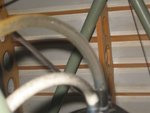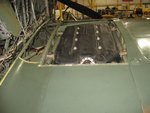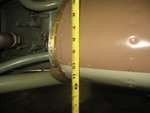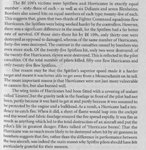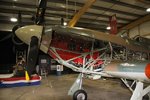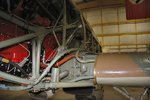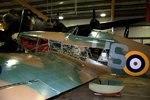Navigation
Install the app
How to install the app on iOS
Follow along with the video below to see how to install our site as a web app on your home screen.
Note: This feature may not be available in some browsers.
More options
You are using an out of date browser. It may not display this or other websites correctly.
You should upgrade or use an alternative browser.
You should upgrade or use an alternative browser.
Hawker Hurricane Mk. IIB vs. Grumman F4F-4 Wildcat (2 Viewers)
- Thread starter DAVIDICUS
- Start date
Ad: This forum contains affiliate links to products on Amazon and eBay. More information in Terms and rules
More options
Who Replied?FLYBOYJ
"THE GREAT GAZOO"
I think the Radial had the survivability factory, no doubt.I should have said "was it just the radial engine or.." the radial engine obviously increasing survivabillity.
But what in the Wildcat's structure made it "tougher" than the Hurricane?
And a side question: which a/c would have been easier to repair in field conditions? (engine aside)
The Wildcat was all aluminum with "many" ribs, longerons, bulkheads all held together with solid rivets. From what I remembered the thinnest part of its skin was .032, the thickest between .064 and higher in some places - I'm guessing by eyeball, I didn't have a calliper with me to measure exact.
The Hurricane seemed to have almost a "tight picket fence" of stringers in its fuselage and like the Wildcat almost seemed to be over engineered. I remember the "turtleback"having a cluster supporting each station and it would seem that was almost the strongest part of the fuselage. From what I remember the wings seemed very strong and I do remember 2 main spars. I also remember the control surfaces seeming less robust when compared to the rest of the aircraft, probably Camm's efforts to keep the control surfaces light.
FLYBOYJ
"THE GREAT GAZOO"
Great shots PB - any more?
renrich
Chief Master Sergeant
There were 1734 F4U1s delivered to the US. All had 237 gallon fuselage tanks that were self sealing and 62 gallon tanks in each wing that were unprotected but with the CO2 system mentioned by R Leonard for a total of 361 gallons of internal fuel. These models could also carry a centerline external tank of 175 gallons. A "yardstick" range for that model with full internal and external tanks was around 2200 miles. Many F4U1s with the wing tanks saw combat. The following is an anecdote I am quoting from memory: In Boone Guyton's book about the Corsair, "Whistling Death," Guyton, a former Navy pilot but the chief test pilot in the Corsair development was chewed out by a Navy admiral during the war because the CO2 bottle for the fuel tank dilution system was located next to the CO2 bottle for the emergency blow down landing gear system. During combat in the Pacific a Navy pilot got ahold of the wrong bottle and instead of diluting the fuel tanks he blew down his landing gear which could not then be retracted. Because of the additional drag he was then shot down and killed. The admiral told Guyton in no uncertain terms that they needed to pilot proof that design and Guyton went back to the factory and they immediately changed the design, separating the bottles.
pbfoot
1st Lieutenant
lots any thing in particularGreat shots PB - any more?
FLYBOYJ
"THE GREAT GAZOO"
Cockpit and fuselage structure?lots any thing in particular
Hi Pbfoot,
>lots any thing in particular
Would it be possible to post the photographs over on the Technical subforum? Your pictures seem to be just the kind of first-rate material Micdrow is always on the look-out for
They'll probably also find a larger audience than here on page x of a long, long discussion thread
Regards,
Henning (HoHun)
>lots any thing in particular
Would it be possible to post the photographs over on the Technical subforum? Your pictures seem to be just the kind of first-rate material Micdrow is always on the look-out for
They'll probably also find a larger audience than here on page x of a long, long discussion thread
Regards,
Henning (HoHun)
Just do a google search for Hawker Restorations. They have many fine photos of Hurricanes under restoration and lots of info.
I guess we can agree that all F4Us had a 237 gal fuel tank sitting right in front of the pilot. Thats 8 times the size of the Hurricanes 28 gal reserve tank and a much bigger target.
Hohun: Actually bullets from the rear would have to pass through the fireproof bulkhead to get to the reserve tank. Anyways its a small target and its well protected, far better than most rear mounted fuel tanks.
As far as the survivability of the spit vs hurri during the BoB. It depends on how you interpret the stats. Hurricanes formed the majority of 10 Group which saw by far the most action during the BoB. They also were vectored more often to the bombers which even when surprised could still hit back.
Elvis two things
Hawker had a great reputation for building tough fighters. I guess it depends on where you live. Take a look at their WW II lineup. The Hurricane, Typhoon, Tempest and the Sea Fury. Thats a very tough group of fighters.
These fighters are as big and rugged as any made during the war.
On rating "Bloody Shambles". Its easily the best books I've read on The Commonwealth contribution to the air war in SE Asia. They filled a big gap in my collection. I've got some excellant books on BoB , North Afrika ect.
The only short coming I can see is that if you dont know your planes you might need a copy of Janes beside you. Probably not a problem for the people who post here.
Overall the toughness of a fighter is a quality that is hard to measure. I think I've made some strong points
- the blast resistant structure
- the large amount of steel used
- the thickness and construction ,steel spars, of the wings
( they are 18inches thick)
chord at root 8 ft1/4 inch aerofoil section 19 % = 18.24"
The reason I started down this path was people were posting that the Wildcat would have a big edge in toughness based on not much more than their opinion
Gotta go for now
Slaterat
I guess we can agree that all F4Us had a 237 gal fuel tank sitting right in front of the pilot. Thats 8 times the size of the Hurricanes 28 gal reserve tank and a much bigger target.
Hohun: Actually bullets from the rear would have to pass through the fireproof bulkhead to get to the reserve tank. Anyways its a small target and its well protected, far better than most rear mounted fuel tanks.
As far as the survivability of the spit vs hurri during the BoB. It depends on how you interpret the stats. Hurricanes formed the majority of 10 Group which saw by far the most action during the BoB. They also were vectored more often to the bombers which even when surprised could still hit back.
Elvis two things
Hawker had a great reputation for building tough fighters. I guess it depends on where you live. Take a look at their WW II lineup. The Hurricane, Typhoon, Tempest and the Sea Fury. Thats a very tough group of fighters.
These fighters are as big and rugged as any made during the war.
On rating "Bloody Shambles". Its easily the best books I've read on The Commonwealth contribution to the air war in SE Asia. They filled a big gap in my collection. I've got some excellant books on BoB , North Afrika ect.
The only short coming I can see is that if you dont know your planes you might need a copy of Janes beside you. Probably not a problem for the people who post here.
Overall the toughness of a fighter is a quality that is hard to measure. I think I've made some strong points
- the blast resistant structure
- the large amount of steel used
- the thickness and construction ,steel spars, of the wings
( they are 18inches thick)
chord at root 8 ft1/4 inch aerofoil section 19 % = 18.24"
The reason I started down this path was people were posting that the Wildcat would have a big edge in toughness based on not much more than their opinion
Gotta go for now
Slaterat
kool kitty89
Senior Master Sergeant
Structure aside, the radial engine gives a big advantage to damage resistance.
pbfoot
1st Lieutenant
I trust my tape measure- the thickness and construction ,steel spars, of the wings
( they are 18inches thick)
chord at root 8 ft1/4 inch aerofoil section 19 % = 18.24"
Slaterat
Hi Slaterat,
>Hohun: Actually bullets from the rear would have to pass through the fireproof bulkhead to get to the reserve tank. Anyways its a small target and its well protected, far better than most rear mounted fuel tanks.
Well, Bungay maintains that during the Battle of Britain, there was no fireproof bulkhead, and I've read enough accounts of pilots burned by or at least dowsed in fuel from the forward tank that it was a real risk, regardless if there was a fireproof bulkhead or not.
What's more, Bungay quotes figures from operational losses showing that the Hurricane did not stand up to enemy fire as well as the Spitfire. Please have a bit of patience while I try to find that quote ... should have noted the page number on reading it first! :-/
Regards,
Henning (HoHun)
>Hohun: Actually bullets from the rear would have to pass through the fireproof bulkhead to get to the reserve tank. Anyways its a small target and its well protected, far better than most rear mounted fuel tanks.
Well, Bungay maintains that during the Battle of Britain, there was no fireproof bulkhead, and I've read enough accounts of pilots burned by or at least dowsed in fuel from the forward tank that it was a real risk, regardless if there was a fireproof bulkhead or not.
What's more, Bungay quotes figures from operational losses showing that the Hurricane did not stand up to enemy fire as well as the Spitfire. Please have a bit of patience while I try to find that quote ... should have noted the page number on reading it first! :-/
Regards,
Henning (HoHun)
renrich
Chief Master Sergeant
The Corsair fuselage tank was self sealing and had armor over the top and was protected from the rear by the armor behind the pilot. Only 189 were shot down by enemy AC in WW2 and the Corsair had 2155 kills. I don't think the Sea Fury was ever operational in WW2.
I 've measured the thickness of a Hurricane wing too PB, There was one leaning against the wall at the air museum in Calgary. It is 18 inches thick at the gun bay in the middle of the wing at the thickest section.. You're position of the tape is not right for an accurate reading. I'll trust the numbers form a reprint of the Hurricane manual used by tha actual ground crews.
I admit the air cooled radial is tougher than the liquid coolled merlin. I accept it as a fact. Just as I accept the fact that steel is stronger than aluminum.
Slaterat
I admit the air cooled radial is tougher than the liquid coolled merlin. I accept it as a fact. Just as I accept the fact that steel is stronger than aluminum.
Slaterat
Hi again,
>What's more, Bungay quotes figures from operational losses showing that the Hurricane did not stand up to enemy fire as well as the Spitfire. Please have a bit of patience while I try to find that quote ... should have noted the page number on reading it first! :-/
Here it is: Stephen Bungay, "The Most Dangerous Enemy", p. 197, on the period 10 July - 11 August 1940:
"However, there was a significant difference in the result, for the Spitfires had a far better rate of survival. Of those sixty-three hit by Bf 109s, only thirty-one were destroyed as opposed to damaged, whereas of the same number of Hurricanes, forty-five were destroyed. The contrast in the casualies caused by bombers ewas even more stark. Of the twendty-five Spitfires hit, only two were destroyed; of the twenty-five Hurricanes, eleven were destryoed. This is reflected in the pilot casualties. Of the total number of pilots killed, fifty-one flew Hurricanes and only twenty-five flew Spitfires."
(The rest of the text in the scans. Quite a good book, by the way - highly recommended!)
Regards,
Henning (HoHun)
>What's more, Bungay quotes figures from operational losses showing that the Hurricane did not stand up to enemy fire as well as the Spitfire. Please have a bit of patience while I try to find that quote ... should have noted the page number on reading it first! :-/
Here it is: Stephen Bungay, "The Most Dangerous Enemy", p. 197, on the period 10 July - 11 August 1940:
"However, there was a significant difference in the result, for the Spitfires had a far better rate of survival. Of those sixty-three hit by Bf 109s, only thirty-one were destroyed as opposed to damaged, whereas of the same number of Hurricanes, forty-five were destroyed. The contrast in the casualies caused by bombers ewas even more stark. Of the twendty-five Spitfires hit, only two were destroyed; of the twenty-five Hurricanes, eleven were destryoed. This is reflected in the pilot casualties. Of the total number of pilots killed, fifty-one flew Hurricanes and only twenty-five flew Spitfires."
(The rest of the text in the scans. Quite a good book, by the way - highly recommended!)
Regards,
Henning (HoHun)
Attachments
FLYBOYJ
"THE GREAT GAZOO"
The reason I started down this path was people were posting that the Wildcat would have a big edge in toughness based on not much more than their opinion
Gotta go for now
Slaterat
Sure, a lot of it is based on opinion.
BTW I've spent almost 30 years in aviation and have worked on several different warbirds - everyone has opinions but I would also consider the source.
pbfoot
1st Lieutenant
Always assumed the thickest part of a wing would be at the root it looks to be about 16" thick without touching the paint and maybe the one I measured is incorrect, they are rebuilding another hurris wings a couple miles away I'll ask the guys rebuilding themI 've measured the thickness of a Hurricane wing too PB, There was one leaning against the wall at the air museum in Calgary. It is 18 inches thick at the gun bay in the middle of the wing at the thickest section.. You're position of the tape is not right for an accurate reading. I'll trust the numbers form a reprint of the Hurricane manual used by tha actual ground crews.
I admit the air cooled radial is tougher than the liquid coolled merlin. I accept it as a fact. Just as I accept the fact that steel is stronger than aluminum.
Slaterat
Attachments
FLYBOYJ
"THE GREAT GAZOO"
Nice shots!!!!
kool kitty89
Senior Master Sergeant
Fires on the Wing tanks would at least allow the Pilot to bail out safely. Plus I thought Linatex wasn't particularly effective sealing material iirc, was this changed in later models? (the Buffalo Mk.I used a layer of Linatex covered with a layer of Horsehide leather for its tanks and this wasn't particularly effective either iirc) I believe the RAF disliked such tanks with "external self sealing" hence the reason they requested it not be used on their Tomahawk IIB's.
Elvis
1st Sergeant
I'll second that....and...Chevy Engine Red! YEAH!Nice shots!!!!
NOW that plane's unbeatable!
Elvis
Hi guys, I've got a few minutes to post here before I have to prep the house, we're having easter dinner for 19 at my house today.
Hohun, I remember reading that passage once when I was considering buying that book. I was stunned by what Bungay stated, and I wondered how it could be true after rereading this passage I realized what Bungay had done.
Fortunately my years at university, along time ago, taught me to be a critical reader. Bungay is outright guilty of statisical manipulation to the verge of lying. First you need to examine his sampling. He has chosen July 10th as the beginning, and that date is , speaking very generally here, considered the start of the BoB. His sample ends on Aug 11. Why pick this date? Why not use sampling from the entire BoB?
I will tell you why, because Aug 11th 1940 was a very bad day for Hurricanes in the BoB( compared to spitfires that day). On that day a force of about 36 Hurrricanes from various squadrons fell into a very well arranged trap. Kudos to the Luftwaffe for excellant tactical planning. No less than 25 Hurricanes were completely destroyed by 109s that day.
Over the course of the entire Bob from June 1940 to the week of Nov 2 there were the loss of 752 Hurricanes and 431 Spitfires. Given that the deployment ratio was about 66% Hurricanes to 33% Spitfires , the survivability rate slightly favours the Hurricane with 63% of casualties and the Spitfire with 36%. Allowing for other variables the survival rate is overall about the same. As the spitfire was the better performing of the two the Hurricane must of had some other factor contributing to its success.
In any case the deficiencies in the protection for the reserve fuel tank were fully rectified in all Hurricane Mk IIs. Also a large number of fires in Spitfire mkIs and Hurricane Mk Is were fires from using 100% glycol for cooling. The glycol header tank on the Hurricane is right in front of the reserve fuel tank.
This was remedied in the Mk IIs with mixed water/glycol cooling and armour for the glycol header tank.
My sources are two books I highly reccommend for the BoB. Both have day by day accounts of the battle and cross referencing with German records.
" The Narrow Margin", Derek Wood and Derek Dempster
You can probably find this one in paperback in a used book store.
"Battle Over Britain" Francic K Mason, 1969. This is the Bible on the BoB 600 pages , day to day accounts and meticulous detail of losses on both sides.
The best book on the BoB ever written. Unfortunately probably fairly hard to find.
Slaterat
Hohun, I remember reading that passage once when I was considering buying that book. I was stunned by what Bungay stated, and I wondered how it could be true after rereading this passage I realized what Bungay had done.
Fortunately my years at university, along time ago, taught me to be a critical reader. Bungay is outright guilty of statisical manipulation to the verge of lying. First you need to examine his sampling. He has chosen July 10th as the beginning, and that date is , speaking very generally here, considered the start of the BoB. His sample ends on Aug 11. Why pick this date? Why not use sampling from the entire BoB?
I will tell you why, because Aug 11th 1940 was a very bad day for Hurricanes in the BoB( compared to spitfires that day). On that day a force of about 36 Hurrricanes from various squadrons fell into a very well arranged trap. Kudos to the Luftwaffe for excellant tactical planning. No less than 25 Hurricanes were completely destroyed by 109s that day.
Over the course of the entire Bob from June 1940 to the week of Nov 2 there were the loss of 752 Hurricanes and 431 Spitfires. Given that the deployment ratio was about 66% Hurricanes to 33% Spitfires , the survivability rate slightly favours the Hurricane with 63% of casualties and the Spitfire with 36%. Allowing for other variables the survival rate is overall about the same. As the spitfire was the better performing of the two the Hurricane must of had some other factor contributing to its success.
In any case the deficiencies in the protection for the reserve fuel tank were fully rectified in all Hurricane Mk IIs. Also a large number of fires in Spitfire mkIs and Hurricane Mk Is were fires from using 100% glycol for cooling. The glycol header tank on the Hurricane is right in front of the reserve fuel tank.
This was remedied in the Mk IIs with mixed water/glycol cooling and armour for the glycol header tank.
My sources are two books I highly reccommend for the BoB. Both have day by day accounts of the battle and cross referencing with German records.
" The Narrow Margin", Derek Wood and Derek Dempster
You can probably find this one in paperback in a used book store.
"Battle Over Britain" Francic K Mason, 1969. This is the Bible on the BoB 600 pages , day to day accounts and meticulous detail of losses on both sides.
The best book on the BoB ever written. Unfortunately probably fairly hard to find.
Slaterat
Users who are viewing this thread
Total: 3 (members: 0, guests: 3)

